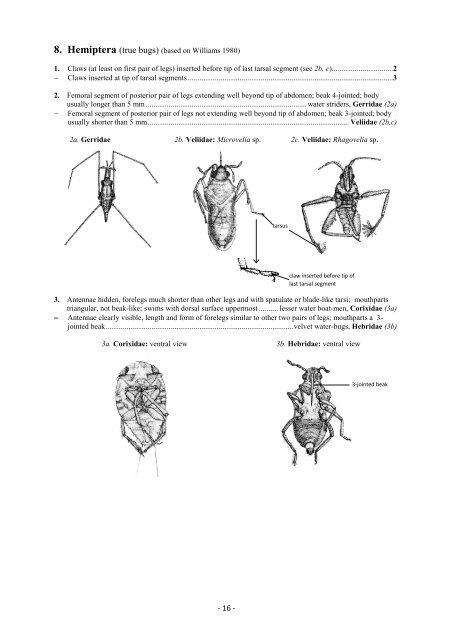Guide riffle invertebrates Australian Wet Tropics streams
1709Guidetotheriffleinvertebrates
1709Guidetotheriffleinvertebrates
Create successful ePaper yourself
Turn your PDF publications into a flip-book with our unique Google optimized e-Paper software.
8. Hemiptera (true bugs) (based on Williams 1980)<br />
1. Claws (at least on first pair of legs) inserted before tip of last tarsal segment (see 2b, c)................................2<br />
− Claws inserted at tip of tarsal segments ...........................................................................................................3<br />
2. Femoral segment of posterior pair of legs extending well beyond tip of abdomen; beak 4-jointed; body<br />
usually longer than 5 mm .................................................................................... water striders, Gerridae (2a)<br />
− Femoral segment of posterior pair of legs not extending well beyond tip of abdomen; beak 3-jointed; body<br />
usually shorter than 5 mm ......................................................................................................... Veliidae (2b,c)<br />
2a. Gerridae 2b. Veliidae: Microvelia sp. 2c. Veliidae: Rhagovelia sp.<br />
tarsus<br />
claw inserted before tip of<br />
last tarsal segment<br />
3. Antennae hidden, forelegs much shorter than other legs and with spatulate or blade-like tarsi; mouthparts<br />
triangular, not beak-like; swims with dorsal surface uppermost .......... lesser water boat-men, Corixidae (3a)<br />
− Antennae clearly visible, length and form of forelegs similar to other two pairs of legs; mouthparts a 3-<br />
jointed beak .................................................................................................. velvet water-bugs, Hebridae (3b)<br />
3a. Corixidae: ventral view 3b. Hebridae: ventral view<br />
3-jointed beak<br />
- 16 -


